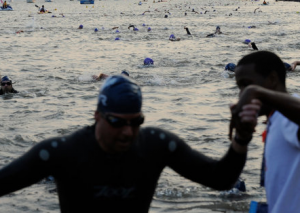Last week, two triathletes died during the swim portion of the New York Triathlon. One of them was from the Chicago area – 40 years young and in excellent health.
So why did this happen?
At this point, no one can really say with 100% certainty. But here is a very telling quote from a piece in today’s New York Times:
“So many things can go wrong in an open-water swim,” Dr. Stuart Weiss, the New York City Triathlon medical director, said last week. “There’s some combination of water, adrenaline, pushing yourself hard, and all these things somehow work together to put people into an abnormal heart rhythm.”
Two years ago, after yet another reported triathlon swimming fatality, I highlighted what I believed to be a growing area of concern for the endurance sports community:
We’ve gone beyond this being an incident or a series – we now have an established pattern. I personally think it’s high time the endurance sports community recognizes this potential risk and addresses it during both training and events. In other words, we need to look more at how we’re preparing people to manage both open water swimming conditions as well as the high stress/anxiety scenarios inherent with triathlons.
I still stand by these comments.
The bottom line is that triathlons have exploded in popularity over the last five years, and legions of event organizers and triathlon coaches have sprung up all over the country trying to service this demand.
But unfortunately, there is very little science-based training given to amateur athletes in the critical area of pre-race and in-race heart rate management.
Whenever I do individual open water swim training, the cardinal point that I hammer home to my clients is the importance of effectively monitoring and managing your heart rate – and by extension your respiration rate – at the front end of the swim. I explain the science and physiology behind immersion shock, hyperventilation, and panic, and I teach specific techniques to manage one’s heart rate to avoid the downward spiral into such niceties as sinus tachycardia and drowning.
Why? Because you can learn all the latest swim techniques from any number of certified triathlon coaches. And you can drill for hours on end in the pool.
But none of this really matters if you can’t effectively manage your own unique physiology within the highly uncertain – and often chaotic – environment of open water swimming.
_________________________________________________________________
GET THE EDGE OVER THE PACK!
Call us at +1 (312) 927-0299 or send us an email, and we’ll talk about your specific needs and how we can tailor a training session just for you.
